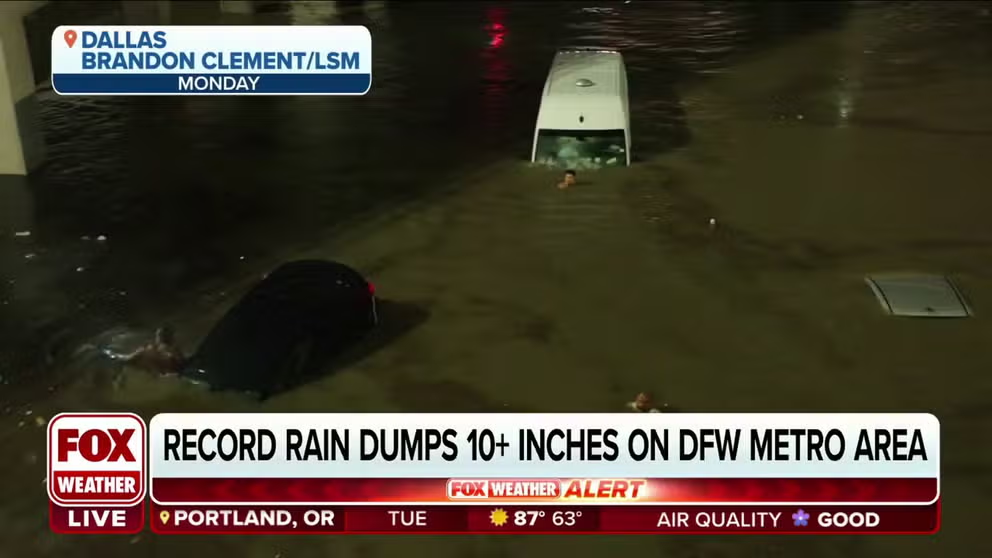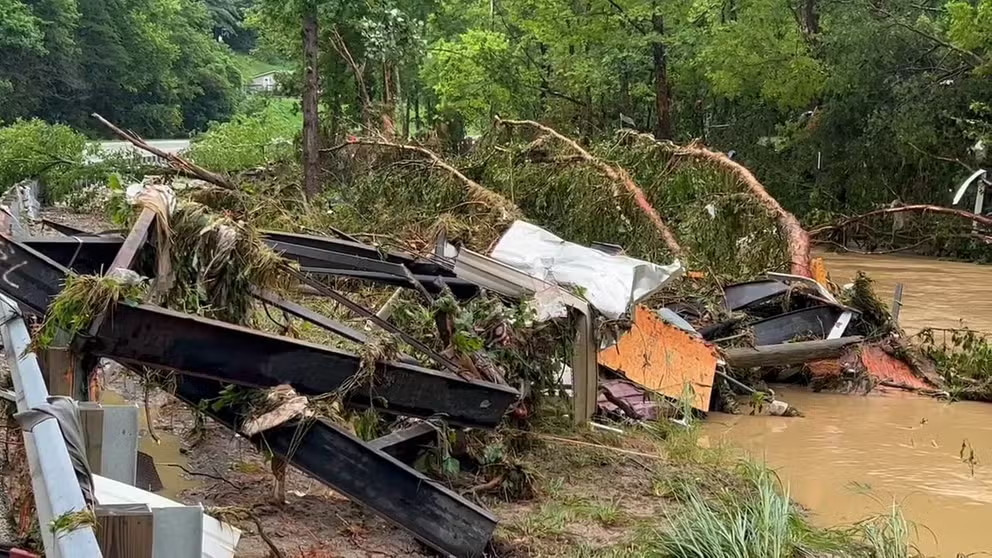6 rare '1,000-year' rain events within a month? Climate change may force NOAA to update criteria
As climate change increases the frequency and intensity of heavy rainfall events in the U.S., NOAA may soon be updating its thresholds for what constitutes a 1,000-year rain event.
Record rainfall dumped 10+ inches on Dallas-Fort Worth Metroplex
A day after record rainfall hit North Texas, FOX Weather's Robert Ray is live at the Trinity River, west of downtown Dallas, which is known for its chronic flooding.
On July 26, 9 inches of rain fell in 24 hours in St. Louis, shattering an all-time record, with over a foot of rain measured in some suburbs.
Two days later, dozens died in eastern Kentucky when more than 10 inches of rain fell, sending rivers rising several feet in hours to well beyond historical record crests and washing away homes near the shores.
Watch: Homes washed away from flooding in Hazard, Kentucky
FOX Weather's Will Nunley captured video of homes being washed away from the catastrophic flooding in Hazard, Kentucky.
As August began, another heavy rain event drenched southeastern Illinois with radar estimates of 10-13 inches of rain in just hours. That same week, the normally arid Death Valley had a year's worth of rainfall in three hours, swamping the region with floodwaters that shut down every road inside the national park, some suffering moderate to severe damage.
Just this week, the Dallas-Fort Worth Metroplex suffered widespread flooding as 3 inches of rain fell in an hour, part of a series of thunderstorms that would drop more than 9 inches at the Dallas-Fort Worth International Airport in 24 hours, with some suburbs in eastern Dallas reporting more than 15 inches of rain.
Not to be outdone, some areas of Mississippi saw more than 8 inches of rain in only three hours on Wednesday morning. The sudden flooding caused the need for dozens of rescues and prompted Flash Flood Emergencies.
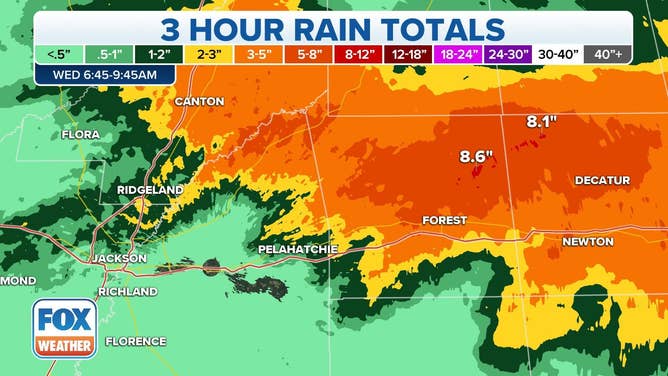
Over 8 inches of rainfall fell in a 3 hour period on Wednesday morning.
(FOX Weather)
7 FACTS YOU SHOULD KNOW ABOUT FLASH FLOODS
All six extreme events reached the local threshold to be classified by the National Weather Service as a "1-in-1,000-year" rainfall event, yet all occurred within the same month, much less a millennium. Last year, deadly flooding that struck New York City and New Jersey from the remnants of Hurricane Ida and catastrophic flooding in west-central Tennessee also qualified as extremely rare 1-in-1,000-year rainfall events.
What does a ‘1-in-1,000-year’ rainfall event mean?
The term "1-in-1,000-year" rainfall event or flood event may sound like something that is only forecast to occur once every thousand years and that once you experience such an event, you'd expect to be in the clear until the year 3022.
That's not quite how it works. Instead, that term is given to an event that forecasters deem only to have a 0.1% chance of occurring in any given year -- a 1 in 1,000 chance. An 0.5% chance is deemed a "1-in-500-year" event, while a 1% chance is a "1-in-100-year" event, and so forth.
ST. LOUIS AND KENTUCKY FLOODING: 2 DIFFERENT 1-in-1,000-YEAR RAINFALL EVENTS IN THE SAME WEEK
The National Oceanic and Atmospheric Administration's Office of Water Prediction oversees researching historical rainfall events across the nation to classify how much rain needs to fall within certain periods (such as an hour, several hours, or days) relative to their climate averages to reach each probability threshold. For example, it took far less rain in Death Valley (just under 1.5 inches) than St. Louis (over 9 inches) to reach the 0.1% probability threshold.
With so many of what are supposed to be exceedingly rare events occurring with much more frequency, you might be wondering if the calculations are off.
According to research from the U.S. Global Change Research Program, climate change is increasing heavy precipitation events in the U.S., both in intensity and in frequency -- particularly in the Northeast and in the Midwest.
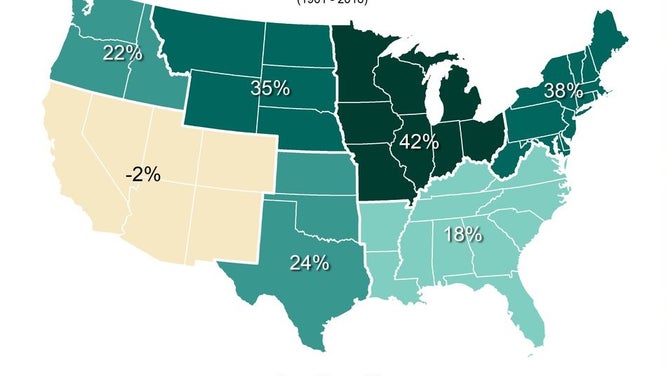
This graph shows the percent change in the precipitation amount occurring as very heavy precipitation.
(U.S. Global Change Research Program)
Warmer ocean temperatures allow increased evaporation and an increase in available water vapor. Meanwhile, warmer air can hold more water vapor. As Earth's temperatures rise with climate change, storms will have access to even more moisture when heavy rainfall events occur, according to the USGCRP.
HOW TO WATCH FOX WEATHER ON TV
According to the U.S. Environmental Protection Agency, nine of the top 10 years for extreme one-day precipitation between 1910 and 2020 have occurred since 1996. The EPA added, "the prevalence of extreme single-day precipitation events remained fairly steady between 1910 and the 1980s, but has risen substantially since then."
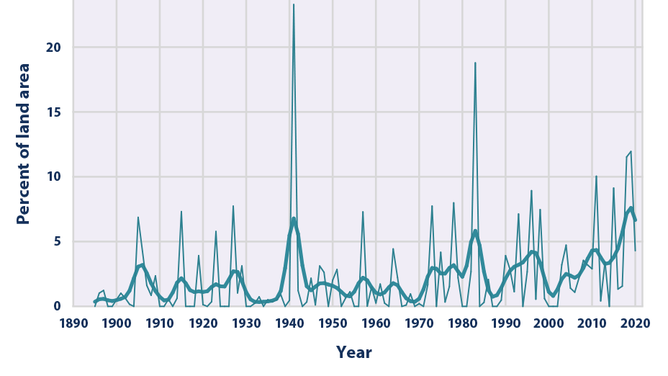
This figure shows the percentage of the land area of the contiguous 48 states that experienced much greater than normal precipitation in any given year.
(NOAA / U.S. Environmental Protection Agency)
NOAA may soon adjust criteria to account for warming planet
The Office of Water Prediction's Hydrometeorological Design Studies Center was already in a yearslong process of researching and updating the precipitation frequency thresholds across the nation and has created interactive maps to allow users to calculate the estimated frequency of certain rainfall amounts in regions where the research is complete. (Note: Research is still underway in 5 states in the Northwest to determine those thresholds.)
NATIONAL WEATHER SERVICE REVAMPS FLOOD ALERTS
However, those maps will likely get a fresh update in the years ahead.
The recently enacted infrastructure law includes funding allowing NOAA to further analyze any changes and trends in observed rainfall events due to climate change and incorporate them into a national update of precipitation frequency estimates. That research is already underway.
1,000-year flood isn't the same as 1,000-year rain
With these extreme and rare rainfall and flooding events making headlines, NOAA stressed that 1-in-1,000-year rain events are not the same as 1-in-1,000-year flood events.
An extreme rainfall event that hits that criteria may not lead to a 1,000-year flood event, just as a 1,000-year flood event may not have been triggered by a 1,000-year rain event. Thus, the terms should not be used interchangeably, according to NOAA.
NOAA is in charge of determining extreme rainfall probabilities, while the United States Geological Survey is in charge of determining such probabilities when it comes to flooding.
